Master Crypto with a Coin Profit Calculator
Go beyond basic numbers. This guide shows you how to use a coin profit calculator to track ROI, account for fees, and inform your crypto trading strategy.

December 13, 2025
Wallet Finder

November 26, 2025
.avif)
If you’ve ever made a trade on Ethereum and been hit with a $50 gas fee, you’re not alone.
Although Ethereum will transfer to a proof-of-stake consensus mechanism, the cost of gas fees remains a tangible problem. An ordinary ETH transfer may not appear expensive; however, add to that smart contract execution, network congestion, block limit problems, and watch transaction fees rapidly soar.
So what’s really driving up your Ethereum gas fees?
It is a combination of high network demand, computational effort, limited network capacity, and the type of transaction you’re trying to make. The straightforward transaction, such as transferring ETH, costs less.
However, you will incur higher gas expenses when using decentralized applications, swapping tokens, or engaging with multifaceted smart contracts.
The good news? You don’t have to just accept these high transaction prices.
Layer-2 solutions such as Arbitrum, Optimism, and Base are currently live, and they provide significantly cheaper transactions to users who leave the Ethereum mainnet behind.
This blog will show you how to avoid high Ethereum gas fees on your next trade with tactics like bridging to low-cost networks, trading off-peak, and batching your actions. It will further show how Wallet Finder.ai helps track wallets already saving the most on fees.
Let’s get started.
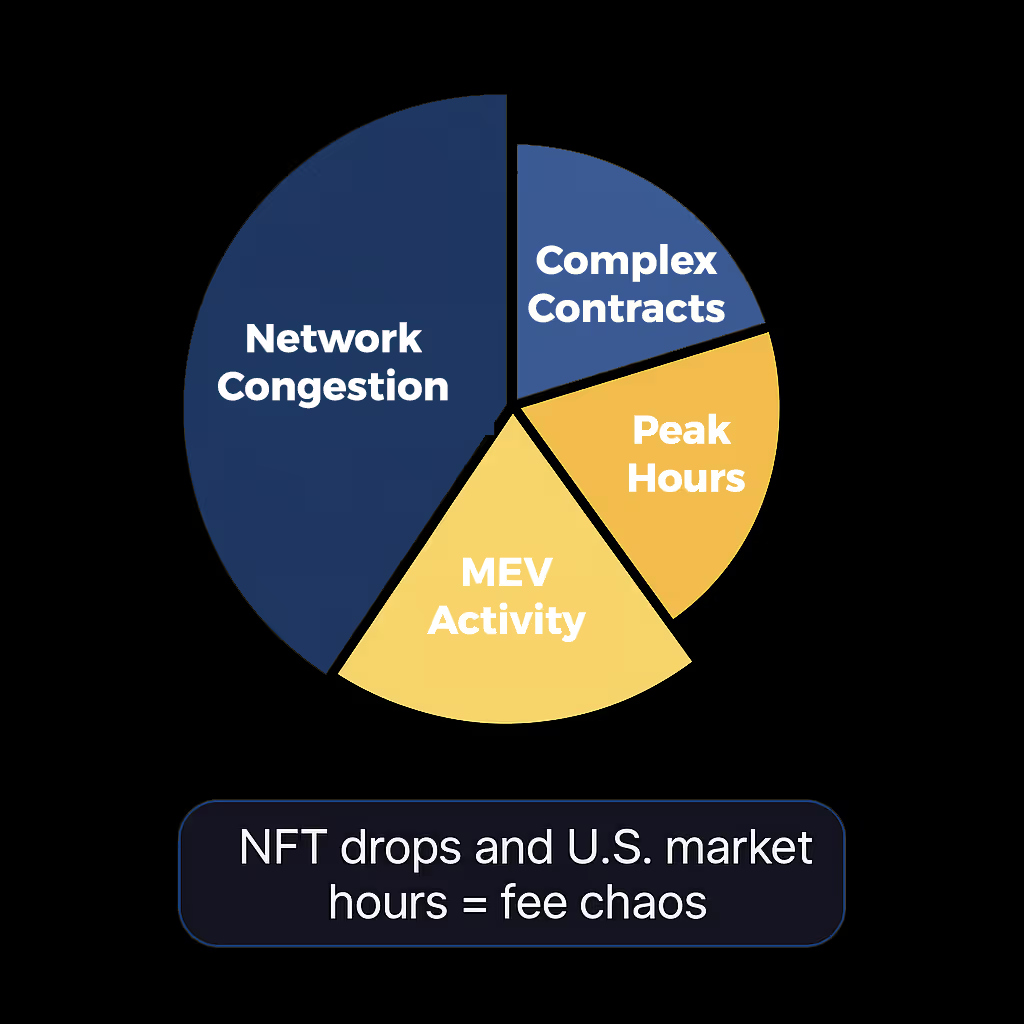
Gas fees on Ethereum can be unpredictable. Yet, there are definite patterns.
When you know what causes them, you can begin to avoid the most egregious of them. What is really going on behind those increasing transaction costs is this:
Ethereum does have a block limit, which implies that it can process only a certain number of transactions. During high network demand, users offer higher fees to process their blockchain transactions. This rivalry causes an increase in gas prices. Events such as NFT mints or token launches may flood the network capacity, which slows transaction times and increases Ethereum gas fees for all users.
For example, a simple ETH transaction might use 21,000 gas, while a DEX swap can use more than 100,000. The more complicated the smart contract execution, the higher the price per unit you'll pay in ETH.
Certain transactions are simply more costly. Trading tokens on a decentralized exchange, such as Uniswap, or creating NFTs requires more complex smart contracts and more computational effort. This means additional gas units are consumed per transaction. To understand how tracking activity across multiple blockchains can help optimize these costs and improve decision-making, our How Cross-Chain Data Improves DeFi Trading guide breaks down why multi-chain analytics matter.
For instance, a basic ETH transfer may cost 21,000 gas, whereas a DEX swap may cost over 100,000. The more complex the smart contract execution, the higher the ETH price per unit you will pay.
MEV, miner extractable value, occurs when bots and sophisticated users attempt to front-run your trade. These bots seek profitable trends and out-compete regular users to skip the queue.
This MEV competition increases transaction fees. You will have to pay more to process your trade and avoid it being sandwiched. This results in unreliable gas expenses, which most traders do not expect during peak network usage.
Timing is everything.
Transactions during network congestion, like U.S. business hours or during a live NFT drop, are expensive. The current base fee rises with each whole block. If the network experiences back-to-back traffic, the base fee will increase, and so will your transaction prices, regardless of whether you are prepared.
If you're trading on Ethereum without a plan, chances are you are overpaying on gas. The cost of gas fees depends on how much one is selling and when, where, and how you trade. Here are five strategies you can implement right away to lower transaction fees.
Moving your assets over a Layer-2 solution such as Arbitrum, Optimism, or Base can reduce your gas costs by a large percentage. These networks process trades off the Ethereum main-net but keep everything secure at the same standard.
Gas prices increase when more people trade. When you are swapping tokens during U.S. business hours or peak time for major token launches, you could pay 2 to 3 times more than usual.
The better option would be trading during Asia's very early morning hours or late at night in the U.S. Before going ahead with your trade, use a gas fee calculator or similar trackers to spot current gas prices.
A major error that traders make is approving and swapping tokens separately. This causes you to pay twice the gas. Many wallets and DEX aggregators allow combining them into a single blockchain transaction, thus cutting the number of types of transactions you send and slashing your total transaction costs.
There are now wallets that support ERC‑4337 using paymasters. In this case, gas fees can be paid using stablecoins or, even better, sponsor wallets. This is very important when you do not want to burn ETH for the smallest interaction, mostly when doing a lot of simple transactions.
Rollups that support the new EIP‑4844 (Dencun) upgrade can store transaction data more efficiently.
This gives slightly lower cost per unit gas and hence cheaper trades compared to older Layer 2 chains. While Base and Optimism are doing this, it is a good way to avoid network congestion in future.
Switching to a Layer-2 solution is one of the most effective ways to reduce your Ethereum gas fees. Here is how to make the move in five steps without overcomplicating things.
Start by picking a Layer-2 network based on your trading needs.
● Arbitrum - offers deep liquidity and supports most major DeFi protocols.
● Optimism - runs on the OP Stack and powers a growing “Superchain” ecosystem.
● Base - backed by Coinbase, has some of the lowest transaction fees and easy on-ramp options.
These networks reduce transaction costs by moving activity off Ethereum’s main layer, but still provide the network’s level of security.
In order to trade on a Layer-2, you will need to transfer your ETH or tokens from the Ethereum mainnet via a bridge. The official bridges (such as Arbitrum Bridge) can take approximately 15 to 30 minutes.
Never trust fake sites; bridge smart contracts are to be audited and verified before usage.
In MetaMask, visit Settings → Networks → Add Network and provide the RPC information of your selected rollup. This is the process of linking your wallet to the new blockchain network, and you are ready to make crypto transactions.
It will only take a minute to add the network manually, and then you will be all set to trade with significantly low gas prices.
Go to a Layer-2 DEX such as Uniswap v3, Sushiswap, Camelot, or Aerodrome. Most tokens are available on these platforms and are much cheaper to use than the Ethereum main-net.
Trade on L2 and you will not participate in the network congestion, nor will you have to control your gas costs, even during the most active times.
Once you're trading, connect your wallet to Wallet Finder.ai to monitor your performance. You'll see your profit and loss across chains and how much ETH you have spent on gas.
Wallet Finder helps you compare your actual transaction fees across networks, identify cheaper transactions, and follow other wallets that are already making the switch to Layer-2.

If you are trading often or managing multiple wallets, these extra steps can help you save even more on Ethereum gas fees:
Don’t let your wallet auto-fill max gas. During low network activity, setting gas to 10–15 Gwei can keep transaction fees low without slowing down your trade.
Do not have your wallet automatically fill with max gas. When the network activity is low, you can set gas to 10-15 Gwei, and your transaction fee will be low, and it will not affect your trade.
Approve tokens only once with trusted contracts. Prevent unnecessary approval of gas wastage and cancel unutilized permissions regularly to mitigate risk.
Some dApps allow you to pay gas in ERC-20 tokens or let relayers cover the fee. This can turn a costly smart contract execution into a zero-fee transaction for you.
Use tools like Blocknative or TX Spear to track your blockchain transaction in the mempool. You can cancel or replace a stuck trade before it fails and avoid high transaction costs.
Wallet Finder.ai isn’t a trading platform, but it does help you trade smarter by showing you exactly how top wallets reduce Ethereum gas fees. If you’re tired of guessing and want real data before you make a move, here’s how Wallet Finder helps:
Wallet Finder.ai is simple. This is not a trading platform, but it helps anyone trade smarter by showing you how top wallets save Ethereum gas fees. If you are tired of guessing and want real data, then here’s how Wallet Finder.ai can help:
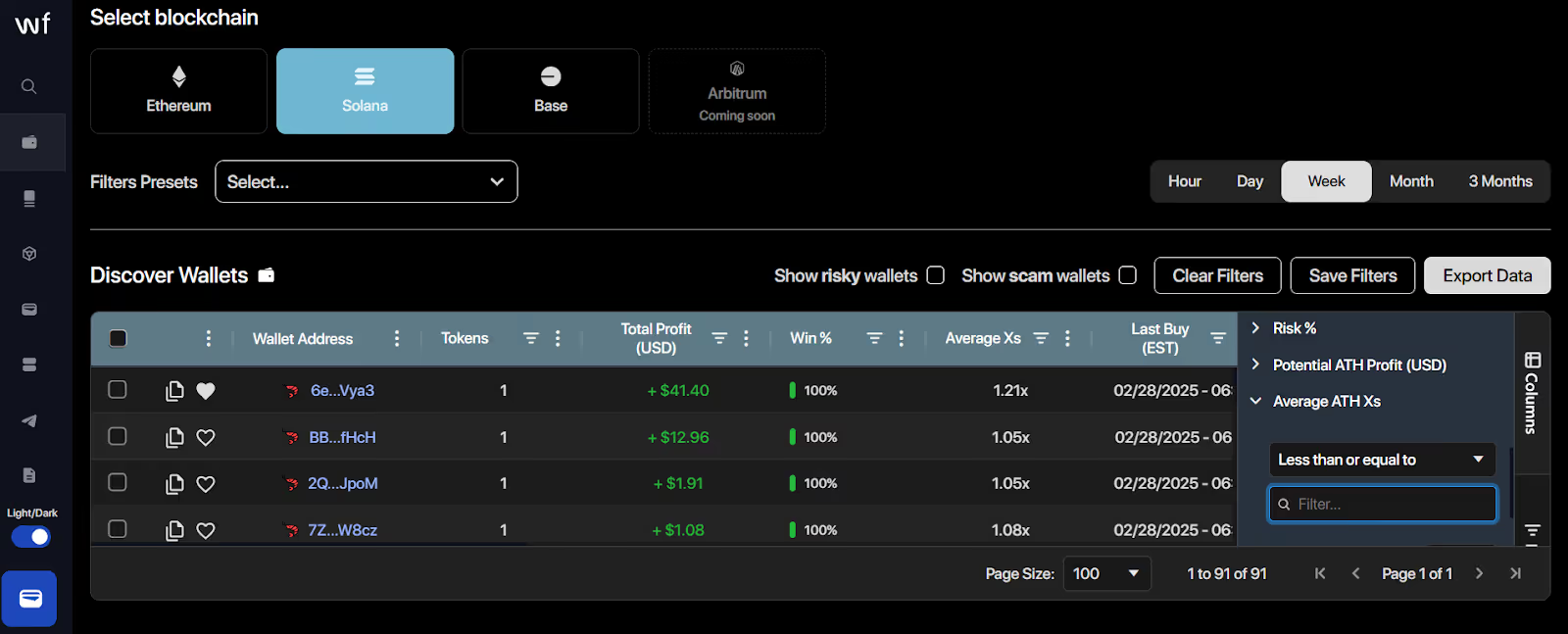
Find wallets that consistently spend less on gas per transaction.
You can filter and sort wallets based on their average gas per transaction and the ones using layer-2 solutions, batching transactions or avoiding busy hours. It is a good means to spot smart traders and follow the same approach.
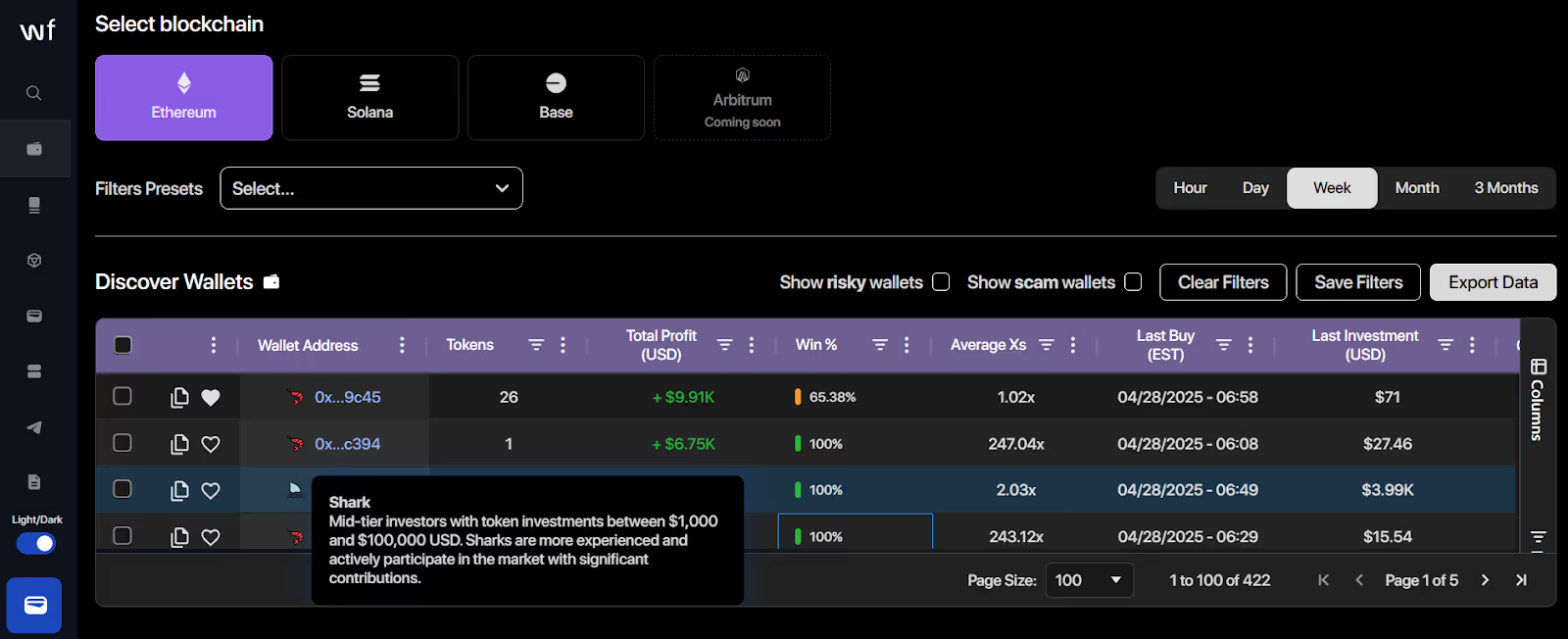
It all comes down to the gas you spend across different chains, before trade.
Wallet Finder.ai's dashboard helps you compare transaction fees between the Ethereum mainnet and cheaper networks like Arbitrum (coming soon) or Base. You don't need to guess about where to trade. Instead, it will clearly indicate which blockchain network is best for a specific type of transaction with advanced wallet analytics.

Follow the wallets that move first when gas costs shift.
When crypto whales link large amounts into Layer-2 wallets, Wallet Finder.ai sends Telegram alerts. It helps you see how the network traffic will trend and act early to access cheaper transactions.
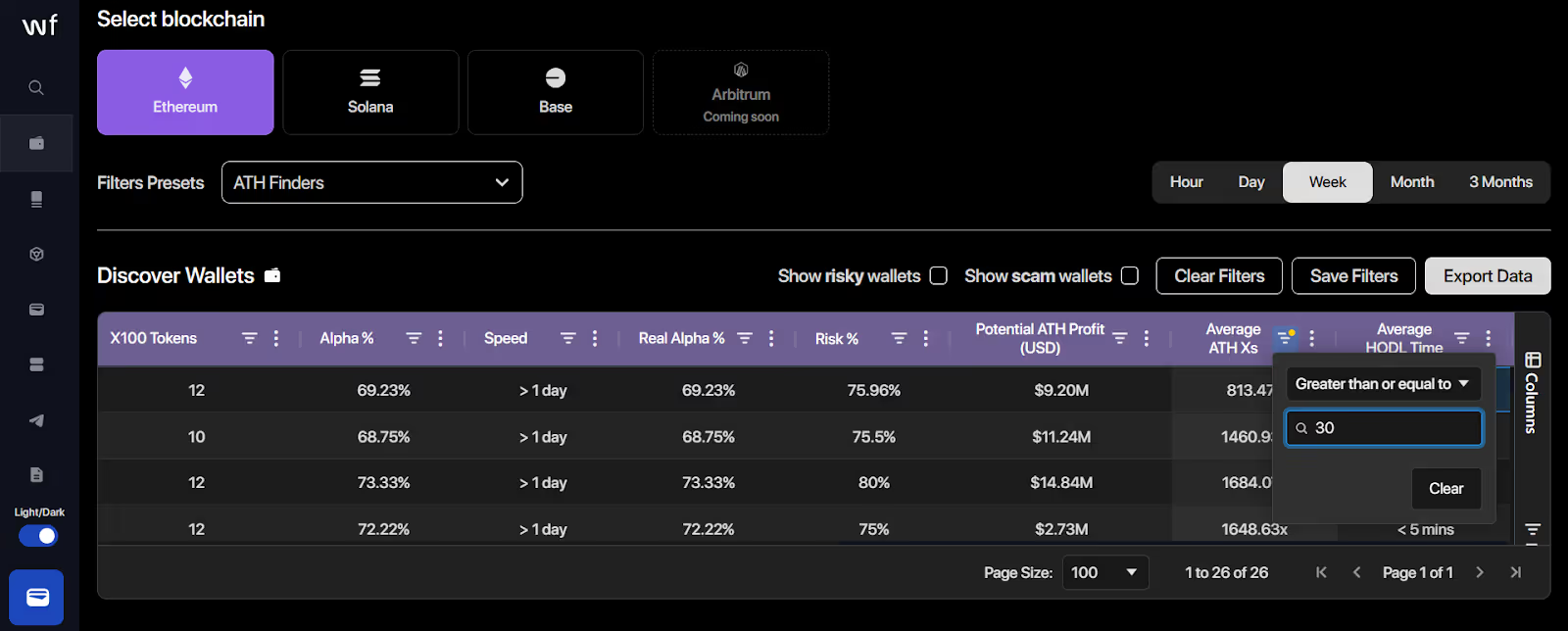
Know exactly how much gas each wallet used, down to the transaction.
Wallet Finder.ai provides you with ETH burned, profits earned, and timing patterns across the trade history of each wallet. This gives you an idea of when it's better to batch approvals, swap off-peak, or stay on Layer-2. This is real data, not guesswork.
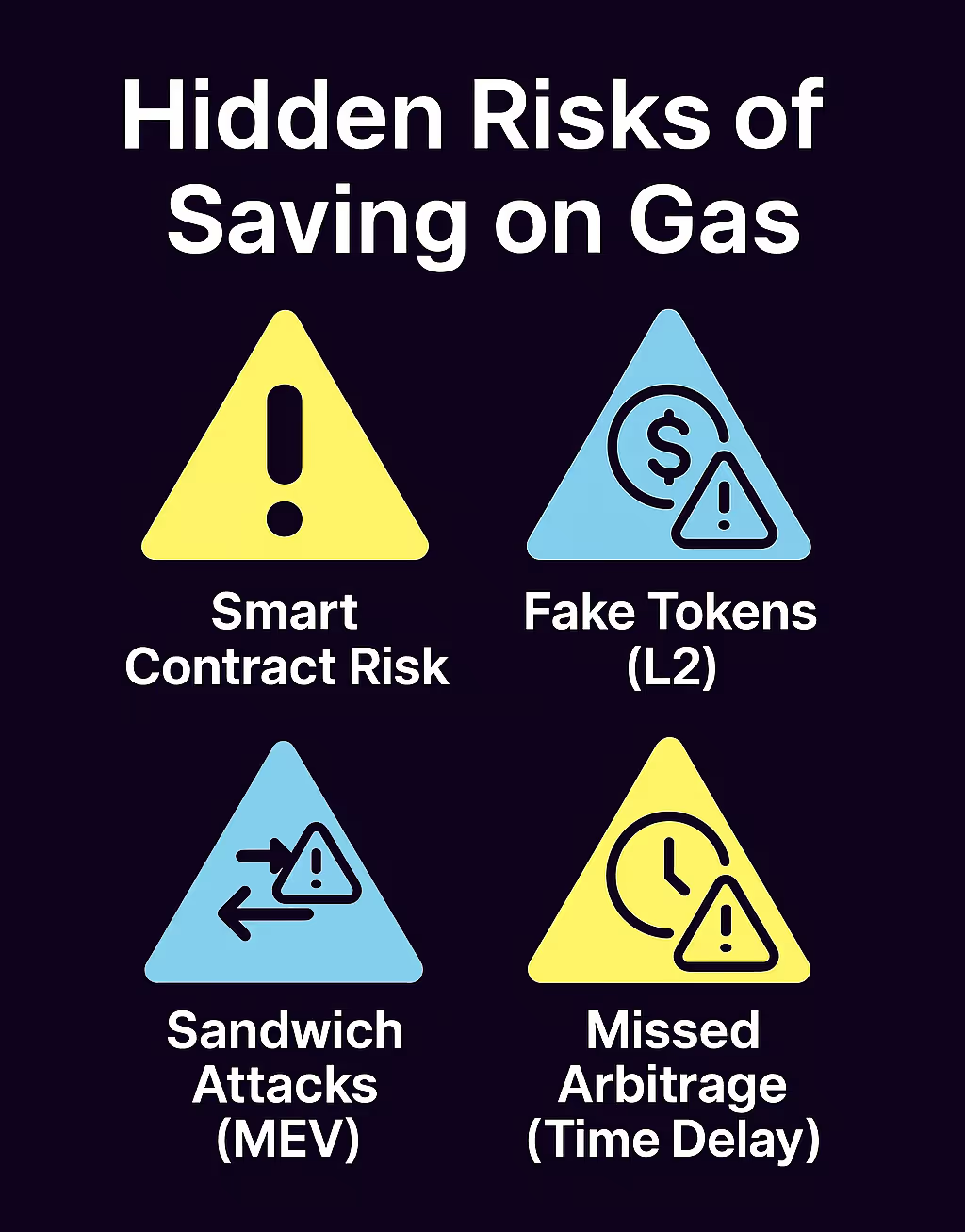
Moving to Layer-2 would save you plenty in Ethereum gas fees, but some things need to be considered. These are not deal-breakers. They are reminders to trade smart and avoid common mistakes.
All bridges are not made equal.
If you are transferring from Ethereum to Layer-2 networks, make sure to utilize official bridges or ones that are audited. Unfamiliar and unverified bridges would put your crypto in danger of smart contract bugs or exploits, especially when processing transactions cross-chains.
Verify Everything Before Trading.
Some tokens on Layer-2s mimic real tokens but, in fact, are fake replicas or scam. Always verify contract addresses before trading by looking up sources you trust, not just that token name. This will help avoid costly bloopers, especially with complex transactions.
Your trade can be affected by bots or front-runners.
MEV (Miner Extractable Value) strategies relating to sandwich attacks can actually cause you to pay more or get a worse price. Maintain good slippage tolerance, and use DEX aggregators that can provide you with an extra layer of MEV protection against additional transaction costs.
There can be a 15-30 minute bridge delay when moving funds from the mainnet to Layer 2. In a volatile market, that may make the difference between catching a price swing and an arbitrage window.
Be sure to plan ahead when you know the trade will be time-sensitive.
You don’t have to wait for Ethereum to fully evolve or for some future upgrade to fix gas fees. There are easy-to-use tools that help reduce your Ethereum gas fees.
You can significantly save costs per transaction by avoiding peak network hours, using Layer-2 solutions, batching approvals for smart contracts, and using wallets that fit your needs. Also, as the Dencun upgrade (EIP‑4844) makes low-cost networks cheaper, it's the right time to switch.
Want to see how your own trades stack up?
Connect your wallet to Wallet Finder.ai to check how much gas you’re spending vs. saving. Benchmark your trades against wallets that are already cutting costs, and get Telegram alerts when they move to cheaper chains. It's the smartest way to trade more.
"I've tried the beta version of Walletfinder.ai extensively and I was blown away by how you can filter through the data, and the massive profitable wallets available in the filter presets, unbelievably valuable for any trader or copy trader. This is unfair advantage."
.avif)
Pablo Massa
Experienced DeFi Trader